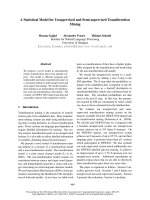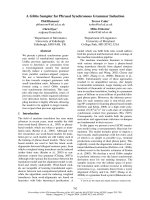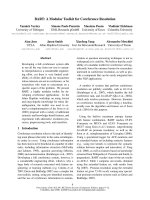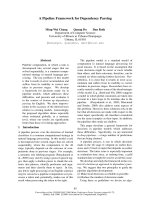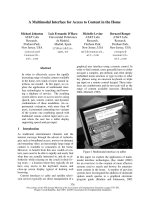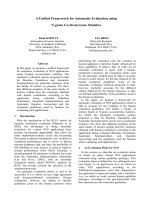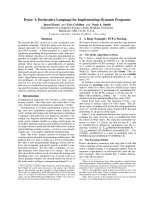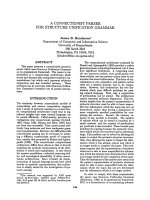Báo cáo khoa học: "A Debug Tool for Practical Grammar Development" doc
Bạn đang xem bản rút gọn của tài liệu. Xem và tải ngay bản đầy đủ của tài liệu tại đây (52.82 KB, 4 trang )
A Debug Tool for Practical Grammar Development
Akane Yakushiji† Yuka Tateisi†‡ Yusuke Miyao†
†Department of Computer Science, University of Tokyo
Hongo 7-3-1, Bunkyo-ku, Tokyo 113-0033 JAPAN
‡CREST, JST (Japan Science and Technology Corporation)
Honcho 4-1-8, Kawaguchi-shi, Saitama 332-0012 JAPAN
{akane,yucca,yusuke,yoshinag,tsujii}@is.s.u-tokyo.ac.jp
Naoki Yoshinaga† Jun’ichi Tsujii†‡
Abstract
We have developed willex, a tool that
helps grammar developers to work effi-
ciently by using annotated corpora and
recording parsing errors. Willex has two
major new functions. First, it decreases
ambiguity of the parsing results by com-
paring them to an annotated corpus and
removing wrong partial results both au-
tomatically and manually. Second, willex
accumulates parsing errors as data for the
developers to clarify the defects of the
grammar statistically. We applied willex
to a large-scale HPSG-style grammar as
an example.
1 Introduction
There is an increasing need for syntactical parsers
for practical usages, such as information extrac-
tion. For example, Yakushiji et al. (2001) extracted
argument structures from biomedical papers using
a parser based on XHPSG (Tateisi et al., 1998),
which is a large-scale HPSG. Although large-scale
and general-purpose grammars have been devel-
oped, they have a problem of limited coverage.
The limits are derived from deficiencies of gram-
mars themselves. For example, XHPSG cannot treat
coordinations of verbs (ex. “Molybdate slowed but
did not prevent the conversion.”) nor reduced rel-
atives (ex. “Rb mutants derived from patients with
retinoblastoma.”). Finding these grammar defects
and modifying them require tremendous human ef-
fort.
Hence, we have developed willex that helps to im-
prove the general-purpose grammars. Willex has two
major functions. First, it reduces a human workload
to improve the general-purpose grammar through
using language intuition encoded in syntactically
tagged corpora in XML format. Second, it records
data of grammar defects to allow developers to have
a whole picture of parsing errors found in the target
corpora to save debugging time and effort by priori-
tizing them.
2 What Is the Ideal Grammar Debugging?
There are already other grammar developing tools,
such as a grammar writer of XTAG (Paroubek et al.,
1992), ALEP (Schmidt et al., 1996), ConTroll (G
¨
otz
and Meurers, 1997), a tool by Nara Institute of Sci-
ence and Technology (Miyata et al., 1999), and [incr
tsdb()] (Oepen et al., 2002). But these tools have
following problems; they largely depend on human
debuggers’ language intuition, they do not help users
to handle large amount of parsing results effectively,
and they let human debuggers correct the bugs one
after another manually and locally.
To cope with these shortcomings, willex proposes
an alternative method for more efficient debugging
process.
The workflow of the conventional grammar devel-
oping tools and willex are different in the following
ways. With the conventional tools, human debug-
gers must check each sentence to find out grammar
defects and modify them one by one. On the other
hand, with willex human debuggers check sentences
that are tagged with syntactical structure, one by
one, find grammar defects, and record them, while
willex collects the whole grammar defect records.
Then human debuggers modify the found grammar
defects. This process allows human debuggers to
make priority over defects that appear more fre-
quently in the corpora, or defects that are more crit-
ical for purposes of syntactical parsing. Indeed, it
is possible for human debuggers using the conven-
tional tools to collect and modify the defects but
willex saves the trouble of human debuggers to col-
lect defects to modify them more efficiently.
3 Functions of willex
To create the new debugging tool, we have extended
will (Imai et al., 1998). Will is a browser of parsing
results of grammars based on feature structures. Will
and willex are implemented in JAVA.
3.1 Using XML Tagged Corpora
Willex uses sentence boundaries, word chunking,
and POSs/labels encoded in XML tagged corpora.
First, with the information of sentence boundaries
and word chunking, ambiguity of sentences is re-
duced, and ambiguity at parsing phase is also re-
duced. A parser connected to willex is assumed to
produce only results consistent with the information.
An example is shown in Figure 1 (<su> is a senten-
tial tag and <np> is a tag for noun phrases).
I saw a girl with a telescope
I saw a girl with a telescope
ᏽ
ᏽᏽ
ᏽ
<su> I saw <np> a girl with a telescope </np></su>
Figure 1: An example of parsing results along with
word chunking
Next, willex compares POSs/labels encoded in
XML tags and parsing results, and deletes improper
parsing trees. Therefore, it reduces numbers of par-
tial parsing trees, which appear in the way of parsing
and should be checked by human debuggers. In ad-
dition, human debuggers can delete partial parsing
trees manually later. Figure 2 shows a concrete ex-
ample. (NP and S are labels for noun and sentential
phrases respectively.)
POS/label from Tagged Corpus
POSs/labels from Partial Results
<NP> A cat </NP> knows everything
A cat
D N
N V
A cat
NP S
ᏽ
ᏽᏽ
ᏽ
Figure 2: An example of deletion by using
POSs/labels
3.2 Output of Grammar Defects
Willex has a function to output information of gram-
mar defects into a file in order to collect the de-
fects data and treat them statistically. In addition,
we can save a log of debugging experiences which
show what grammar defects are found.
An example of an output file is shown in Table
1. It includes sentence numbers, word ranges in
which parsing failed, and comments input by a hu-
man debugger. For example, the first row of the ta-
ble means that the sentence #0 has coordinations of
verb phrases at position #3–#12, which cannot be
parsed. “OK” in the second row means the sen-
tence is parsed correctly (i.e., no grammar defects
are found in the sentence). The third row means that
the word #4 of the sentence #2 has no proper lexical
entry.
The word ranges are specified by human debug-
gers using a GUI, which shows parsing results in
CKY tables and parse trees. The comments are input
by human debuggers in a natural language or chosen
from the list of previous comments. A postprocess-
ing module of willex sorts the error data by the com-
ments to help statistical analysis.
Table 1: An example of file output
Sentence # Word # comment
0 3–12 V-V coordination
1 – OK
2 4 no lexical entry
4 Experiments and Discussion
We have applied willex to rental-XTAG, an HPSG-
style grammar converted from the XTAG English
grammar (The XTAG Research Group, 2001) by a
grammar conversion (Yoshinaga and Miyao, 2001).
1
The corpus used is MEDLINE abstracts with tags
based on a slightly modified version of GDA-
DTD
2
(Hasida, 2003). The corpus is “partially
parsed”; the attachments of prepositional phrases are
annotated manually.
The tags do not always specify the correct struc-
tures based on rental-XTAG (i.e., the grammar as-
sumed by tags is different from rental-XTAG), so we
prepared a POS/label conversion table. We can use
tagged corpora based on various grammars different
from the grammar that the parser is assuming by us-
ing POS/label conversion tables.
We investigated 208 sentences (average 24.2
words) from 26 abstracts. 73 sentences were parsed
successfully and got correct results. Thus the cover-
age was 35.1%.
4.1 Qualitative Evaluation
Willex received three major positive feedbacks from
a user; first, the function of restricting partial results
was helpful, as it allows human debuggers to check
fewer results, second, the function to delete incorrect
partial results manually was useful, because there
are some cases that tags do not specify POSs/labels,
and third, human debuggers could use the record-
ing function to make notes to analyze them carefully
later.
However, willex also received some negative eval-
uations; the process of locating the cause of pars-
ing failure in a sentence was found to be a bit trou-
blesome. Also, willex loses its accuracy if the hu-
man debuggers themselves have trouble understand-
ing the correct syntactical structure of a sentence.
3
1
Since XTAG and rental-XTAG generate equivalent parse
results for the same input, debugging rental-XTAG means de-
bugging XTAG itself.
2
GDA has no tags which specify prepositional phrases, so
we add <prep> and <prepp>.
3
Thus, we divided the process of identifying grammar de-
fects to two steps. First, a non-expert roughly classifies pars-
ing errors and records temporary memorandums. Then, the
non-expert shows typical examples of sentences in each class
to experts and identifies grammar defects based on experts’ in-
ference. Here, we can make use of the recording function of
We found from these evaluations that the func-
tions of willex can be used effectively, though more
automation is needed.
4.2 Quantitative Evaluation
Figure 3 shows the decrease in partial parsing trees
caused by using the tagged corpus. (Data of 10 sen-
tences among the 208 sentences are shown.) The
graph shows that human workload was reduced by
using the tagged corpus.
0
5000
10000
15000
20000
25000
30000
35000
10 15 20 25 30 35 40
number of partial results
length of a sentence (number of words)
without any info.
with chunk info.
with chunk and POS/label info.
Figure 3: Examples of numbers of partial results
4.3 Defects of rental-XTAG
Table 2 shows the defects of rental-XTAG which are
found by using willex.
Table 2: The defects of rental-XTAG
the defects of rental-XTAG #
no lexical entry 62
cannot handle reduced relative 35
cannot handle V-V coordination 22
Adjective does not post-modify NP 9
cannot parse “, but not” 4
cannot handle objective to-infinitive 3
“, which ” does not post-modify NP 3
cannot handle reduced as-relative clause 2
cannot parse “greater than”(“>”) 2
misc. 17
From this table, it is inferred that (1) lack of lexi-
cal entries, (2) inability to parse reduced relative and
willex.
(3) inability to parse coordinations of verbs are seri-
ous problems of rental-XTAG.
4.4 Conflicts Between the Modified GDA and
rental-XTAG
Conflicts between rental-XTAG and the grammar on
which the modified GDA based cause parsing fail-
ures. Statistics of the conflicts is shown in Table 3.
Table 3: Conflicts between the modified GDA and
rental-XTAG
modified GDA rental-XTAG #
adjectival phrase verbal phrase 36
bracketing except “,” 10
bracketing of “,” 8
treatment of omitted words 2
misc. 5
These conflicts cannot be resolved by a simple
POS/label conversion table. One resolution is insert-
ing a preprocess module that deletes and moves tags
which cause conflicts.
We do not consider these conflicts as grammar de-
fects but the difference of grammars to be absorbed
in the conversion phase.
5 Conclusion and Future Work
We developed a debug tool, willex, which uses XML
tagged corpora and outputs information of grammar
defects. By using tagged corpora, willex succeeded
to reduce human workload. And by recording gram-
mar defects, it provides debugging environment with
a bigger perspective. But there remains a prob-
lem that a simple POS/label conversion table is not
enough to resolve conflicts of a debugged grammar
and a grammar assumed by tags. The tool should
support to handle the complicated conflicts.
In the future, we will try to modify willex to infer
causes of parsing errors (semi-)automatically. It is
difficult to find a point of parsing failure automati-
cally, because subsentences that have no correspon-
dent partial results are not always the failed point.
Hence, we will expand willex to find the longest
subsentences that are parsed successfully. Words,
POS/labels and features of the subsentences can be
clues to infer the causes of parsing errors.
References
Thilo G
¨
otz and Walt Detmar Meurers. 1997. The Con-
Troll system as large grammar development platform.
In Proc. of Workshop on Computational Environments
for Grammar Development and Linguistic Engineer-
ing, pages 38–45.
Koiti Hasida. 2003. Global docu-
ment annotation (GDA). available in
/>Hisao Imai, Yusuke Miyao, and Jun’ichi Tsujii. 1998.
GUI for an HPSG parser. In Information Processing
Society of Japan SIG Notes NL-127, pages 173–178,
September. In Japanese.
Takashi Miyata, Kazuma Takaoka, and Yuji Mat-
sumoto. 1999. Implementation of GUI debugger for
unification-based grammar. In Information Process-
ing Society of Japan SIG Notes NL-129, pages 87–94,
January. In Japanese.
Stephan Oepen, Emily M. Bender, Uli Callmeier, Dan
Flickinger, and Melanie Siegel. 2002. Parallel dis-
tributed grammar engineering for practical applica-
tions. In Proc. of the Workshop on Grammar Engi-
neering and Evaluation, pages 15–21.
Patrick Paroubek, Yves Schabes, and Aravind K. Joshi.
1992. XTAG – a graphical workbench for developing
Tree-Adjoining grammars. In Proc. of the 3rd Confer-
ence on Applied Natural Language Processing, pages
216–223.
Paul Schmidt, Axel Theofilidis, Sibylle Rieder, and
Thierry Declerck. 1996. Lean formalisms, linguis-
tic theory, and applications. Grammar development in
ALEP. In Proc. of COLING ’96, volume 1, pages
286–291.
Yuka Tateisi, Kentaro Torisawa, Yusuke Miyao, and
Jun’ichi Tsujii. 1998. Translating the XTAG english
grammar to HPSG. In Proc. of TAG+4 workshop,
pages 172–175.
The XTAG Research Group. 2001. A Lex-
icalized Tree Adjoining Grammar for English.
Technical Report IRCS Research Report 01-03,
IRCS, University of Pennsylvania. available in
/>Akane Yakushiji, Yuka Tateisi, Yusuke Miyao, and
Jun’ichi Tsujii. 2001. Event extraction from biomedi-
cal papers using a full parser. In Pacific Symposium on
Biocomputing 2001, pages 408–419, January.
Naoki Yoshinaga and Yusuke Miyao. 2001. Grammar
conversion from LTAG to HPSG. In Proc. of the sixth
ESSLLI Student Session, pages 309–324.

